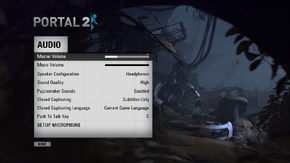Warnings
- The macOS (OS X) version of this game does not work on macOS Catalina (version 10.15) or later due to the removal of support for 32-bit-only apps.
Key points
- Runs well on low-end hardware.[1]
- Includes two-player split-screen co-op and controller support.
- Built-in level editor with Steam Workshop support.[2]
General information
- Official Portal 2 Site
- Official Valve Portal 2 Site
- Unofficial Portal Wiki
- Portal Section of the Half-Life Wikia
- Steam Community Discussions
- Steam Users' Forums
- Steam Workshop for Portal 2
Availability
Template:Availability Table
- All versions require Steam.
PlayStation 3
- PlayStation 3 copies of the game include a Steam code for use on the PC.[3]
- Each PlayStation 3 copy can only be linked to a Steam account once, so take care if buying the game used - all the benefits from linking to Steam may not be available. Similarly, purchasing one PlayStation 3 copy of the game will not allow co-op play with someone using the included PC version.
- Can be linked to a Steam account, which also gives you access to both the PC versions of the game. In addition, linking to Steam allows cross-platform multiplayer with PC players, access to your Steam friend list (chat, invites, etc.), Steam Achievements, and Steam Cloud save-games (not compatible with PC versions).
Essential improvements
Skip intro videos
Game data
Configuration file(s) location
Save game data location
Video settings
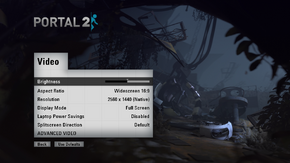
In-game general video settings.
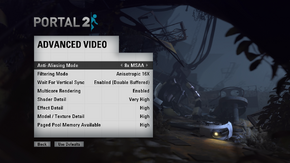
In-game advanced video settings.
Template:Video settings
Split-screen without bezels
- Portal 2 split-screen mode was meant to be played on a single 16:9 screen only. If you have a different setup then, the image could not entirely fit the monitor(s).
Input settings
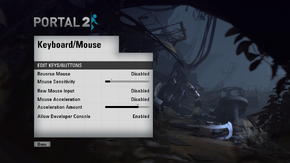
In-game general controls settings.
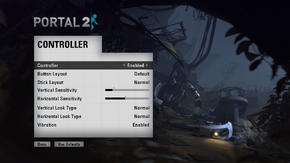
In-game gamepad settings.
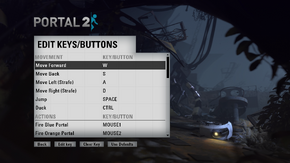
In-game key map settings.
Template:Input settings
Audio settings
Template:Audio settings
Changing subtitle language
Network
Connection types
Ports
| Protocol |
Port(s) and/or port range(s) |
| TCP |
27014-27050 |
| UDP |
3478, 4379-4380, 27000-27030 |
- Universal Plug and Play (UPnP) support status is unknown.
Issues unresolved
Hang on exit
- New patch on July 12, 2013, introduced a crash when exiting the game. Application hangs and does not respond when the game is exited via the quit button on the main menu or task manager. Steam Cloud synchronisation resumes when forcefully quit. No fix has been announced.[4]
Issues fixed
Purple and black broken textures
- A generic fix for this issue can be found on our Source engine page.
Split-screen co-op
- As of November 20th 2012, splitscreen mode has been officially added for Standard Co-Op[5].
- If you'd like to use a keyboard/mouse for Player 1 and a controller for Player 2, follow these instructions:
Black screen at launch
'Visual 2005 Runtime' error
'Portal 2 Failed to create D3D device' error
Freezes after logo intro video
- If you have an FX Bulldozer CPU, such as the AMD FX 4100, you may need to:
'Could not Load Library Client' error
No sound
Sound causing stuttering
Generic crash fixes
Cinematic audio stutter
Lag physics blob fix
Display driver has stopped working
Portal 2 with Integrated Intel Graphics
- Portal 2 may have problems running on integrated Intel graphics cards, including crashing and black screens. Windowed mode may fix this.
Other information
Console commands
- Games running on the Source engine can utilize Source Engine Console Commands for various tasks.
- You can also have the console open by default on launch by following this guide:
Launch options
- View this Steam Support Article regarding launch options as well as the relevant Valve Developer wiki page for further information and a list of useful Source engine launch options.
System requirements
| Windows |
|
Minimum |
| Operating system (OS) |
XP, Vista, 7 |
| Processor (CPU) |
Intel Pentium 4 3.0 GHz or 2 GHz dual-core |
| System memory (RAM) |
|
| Hard disk drive (HDD) |
7.6 GB |
| Video card (GPU) |
128 MB of VRAM
DirectX 9.0 compatible |
| macOS (OS X) |
|
Minimum |
| Operating system (OS) |
10.6.7 |
| Processor (CPU) |
Intel Core Duo 2.0 GHz |
| System memory (RAM) |
|
| Hard disk drive (HDD) |
7.6 GB |
| Video card (GPU) |
NVIDIA GeForce 8600M
ATI Radeon HD 2400
Intel HD Graphics 3000 |
Notes
- ↑ 1.0 1.1 File/folder structure within this directory reflects the path(s) listed for Windows and/or Steam game data (use Wine regedit to access Windows registry paths). Games with Steam Cloud support may store data in
~/.steam/steam/userdata/<user-id>/620/ in addition to or instead of this directory. The app ID (620) may differ in some cases. Treat backslashes as forward slashes. See the glossary page for details.
References






